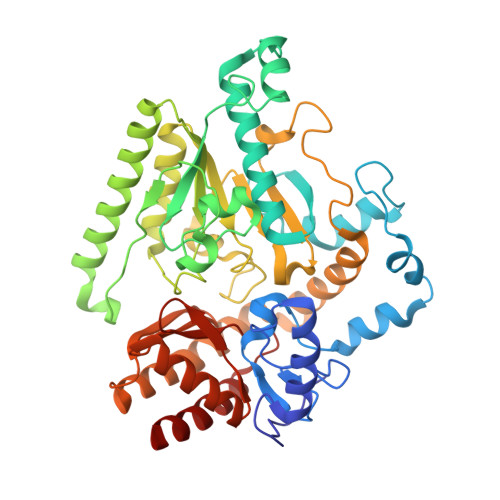Design and Mechanism of (S)-3-Amino-4-(difluoromethylenyl)cyclopent-1-ene-1-carboxylic Acid, a Highly Potent gamma-Aminobutyric Acid Aminotransferase Inactivator for the Treatment of Addiction.
Juncosa, J.I., Takaya, K., Le, H.V., Moschitto, M.J., Weerawarna, P.M., Mascarenhas, R., Liu, D., Dewey, S.L., Silverman, R.B.(2018) J Am Chem Soc 140: 2151-2164
- PubMed: 29381352
- DOI: https://doi.org/10.1021/jacs.7b10965
- Primary Citation of Related Structures:
6B6G - PubMed Abstract:
γ-Aminobutyric acid (GABA) is the major inhibitory neurotransmitter in the central nervous system. Inhibition of GABA aminotransferase (GABA-AT), a pyridoxal 5'-phosphate (PLP)-dependent enzyme that degrades GABA, has been established as a possible strategy for the treatment of substance abuse. The raised GABA levels that occur as a consequence of this inhibition have been found to antagonize the rapid release of dopamine in the ventral striatum (nucleus accumbens) that follows an acute challenge by an addictive substance. In addition, increased GABA levels are also known to elicit an anticonvulsant effect in patients with epilepsy. We previously designed the mechanism-based inactivator (1S,3S)-3-amino-4-difluoromethylenyl-1-cyclopentanoic acid (2), now called CPP-115, that is 186 times more efficient in inactivating GABA-AT than vigabatrin, the only FDA-approved drug that is an inactivator of GABA-AT. CPP-115 was found to have high therapeutic potential for the treatment of cocaine addiction and for a variety of epilepsies, has successfully completed a Phase I safety clinical trial, and was found to be effective in the treatment of infantile spasms (West syndrome). Herein we report the design, using molecular dynamics simulations, synthesis, and biological evaluation of a new mechanism-based inactivator, (S)-3-amino-4-(difluoromethylenyl)cyclopent-1-ene-1-carboxylic acid (5), which was found to be almost 10 times more efficient as an inactivator of GABA-AT than CPP-115. We also present the unexpected crystal structure of 5 bound to GABA-AT, as well as computational analyses used to assist the structure elucidation process. Furthermore, 5 was found to have favorable pharmacokinetic properties and low off-target activities. In vivo studies in freely moving rats showed that 5 was dramatically superior to CPP-115 in suppressing the release of dopamine in the corpus striatum, which occurs subsequent to either an acute cocaine or nicotine challenge. Compound 5 also attenuated increased metabolic demands (neuronal glucose metabolism) in the hippocampus, a brain region that encodes spatial information concerning the environment in which an animal receives a reinforcing or aversive drug. This multidisciplinary computational design to preclinical efficacy approach should be applicable to the design and improvement of mechanism-based inhibitors of other enzymes whose crystal structures and inactivation mechanisms are known.
Organizational Affiliation:
Departments of Chemistry and Molecular Biosciences, Chemistry of Life Processes Institute, Center for Molecular Innovation and Drug Discovery, and Center for Developmental Therapeutics, Northwestern University , Evanston, Illinois 60208, United States.


















